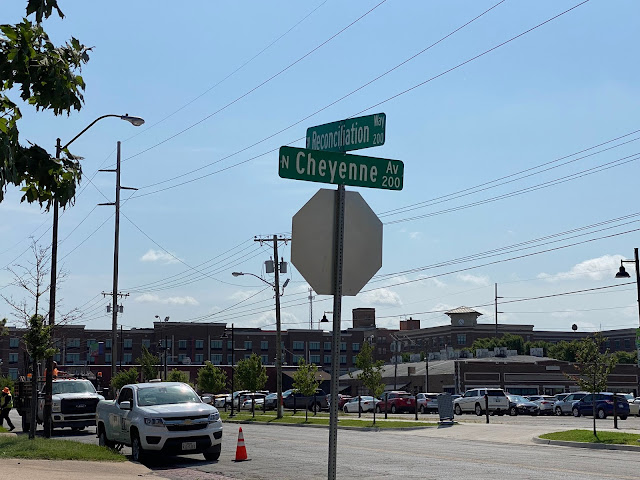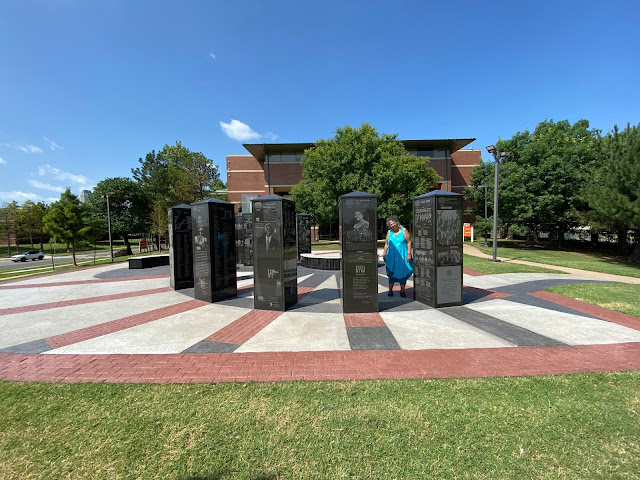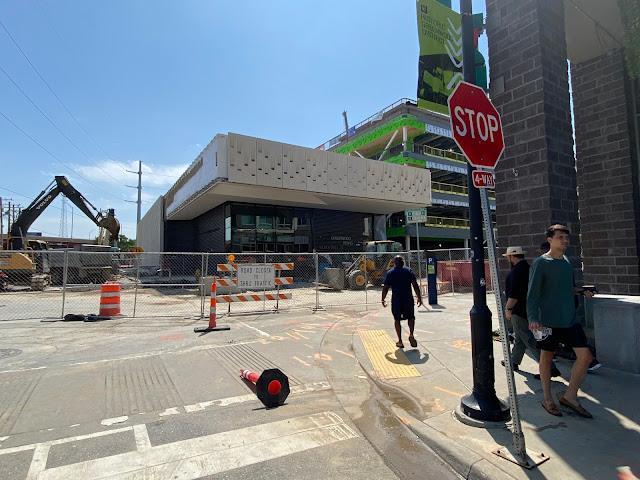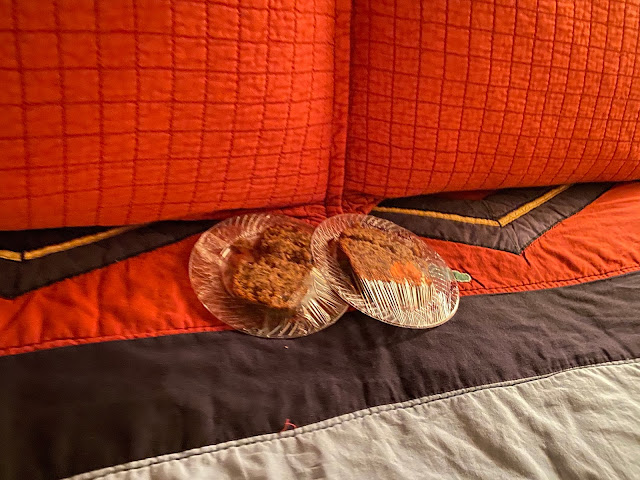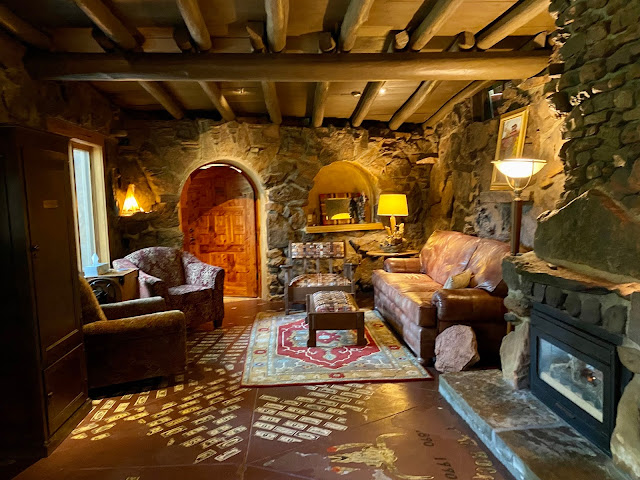There are expressions in the English language that confound me. "Bearing Witness" is one of them. "Speaking truth to power" is another. Sometime in the middle of the pandemic I had this momentary panic that what if I didn't make it through and I never got to bear witness to more of the atrocities that have happened in the US (it had become a sort of mini-obsession of mine years ago)? Then the folks who have tried to cover up or deny our ugly history will prevail. I promised myself that once the country opened up enough, I knew just where I wanted to go.
Oklahoma. Not because of the Rogers and Hammerstein musical either. The ugly history of this place predates even the forming of this US state. Ever since I learned of the Indian Removal Act sometime in early adulthood (and NOT in HighSchool or College) I had been upset. I hate hidden ugly history. When teaching, I would create these adult literacy units of study that posed questions like, "can the United States be accused of practicing genocide for the crimes against the Indigenous folk of this country? We had the freedom to dig deep into these taboo topics back then in adult literacy.
Also back in my adult education days a very inquisitive young black man who really liked history would bring me tough topic questions about lynchings and riots perpetuated against black folk. That's where Tulsa entered the consciousness.
I had been holding these ugly places and spaces in our country's history in my minds' eye for a long time. I often would wonder how people in Oklahoma could carry on with the magnitude of social injustices carried out in their state. Is coexistence even possible? Or is it more like parallel existence or begrudging acceptance? I'm going to go find out.
SO off we went. We traversed a lot of Oklahoma and saw many sites. But...
I start with Tulsa because the anniversary year of the horror experienced here became very well publicized in this centennial year, and has made national news. I wanted to go not only to acknowledge the shameful past, but also check in on how things have changed.
The first change that I noted was a subtle shift of wording to describe the past. What little I knew about the history of "the event" always used the words "race riot" (another phrase I struggle to understand). Now, when NPR broadcasts a story about the black Tulsa event, they use the term "Tulsa's race massacre."
This spring the wires were abuzz about the Tulsa massacre and all the current efforts to address the past, acknowledge the wrongdoings, and even begin to dialogue on how to make things right. And most of all, many folks worked hard to get education out there for all to learn and grow from. A woke country is what we got! I wanted to be in on the "wokedness."
I read two books on this infamous, yet publicly hidden, historical event. Again, the learning wasn't until adulthood and the event was described as a "race riot." It has only been in recent times that the paradigm shift has changed the event from riot to massacre. A BIG difference in historical perspective here. A retelling or reclaiming the true history of this event has been 100 years in the making. I wondered who and how the narrative was now being told.
I find that it is often very hard to read about historical events without a contextual background to ground the information in. So that is why I like to visit. Some places feel old and unchanged, other places feel so changed it is hard to peel off the layers of time and conceptualize the history. Especially if you hadn't lived any part of it.
First realization is how big Tulsa is. I tend to think of most cities in the midwest as being these small places with hitching posts with a cowboyish feel (and trust me we saw several of these small towns on the trip).
Tulsa's population is about 400,000. One hundred years ago it was about 72,000- large by many standards. It was a place that had become many things: a depository for displaced beings (Indigenous tribes into "Indian Territory"), as well as Oil-driven settlers (white folks), and formerly enslaved (***new learning here=Many of the civilized tribes that came to call Oklahoma home came with enslaved black people) black people. Talk about a complex picture. The contours of history are hard to paint.
Between 1865 and 1920, African-Americans created more than 50 all-black towns and settlements throughout Indian Territory. The Land Run of 1889 brought even more African American settlers to the unassigned lands that now make up the state of Oklahoma. Another picture that is hard to conjure up. The land rush, sanctioned by the federal government, let white folks be at the front, and black at the back and only claim land not already taken by their white counterparts. Some industrious, hardy folk all around set about creating what all thought was "theirs for the taking." I wonder what those people who lined up in 1889 thought of the Indian situation at the time? Did they even care of their history? Did they foresee any difficulties coexisting or signs of trouble ahead?
For trouble came. Trouble is still around.
Many videos and books now exist on "Black Tulsa." When I tried to find a book a few years back, I had to go to the nearest city (Springfield MA) and the circulation desk had to go in the basement and pull the book I sought out of the archives b/c it hadn't circulated in years.
Here is a nice documentary done by NBC:
There is a man in the video (85 years old) who says, "I don't choose to be uncomfortable, reality makes me uncomfortable." He is talking about living in the world today as a black person, not 100 years ago. I find this heart wrenching news on the state of race relations today. I makes me not only uncomfortable, but really sad.
Segregation, urban renewal, and gentrification has changed the landscape, but I think it hasn't ended the history of poor race relations and trauma that came from those 18 hours of horror. This feeling is hard to capture as a tourist- as a voyeur on a painful past that isn't your own. What I felt while there was a strange undercurrent feeling of discomfort. Of not knowing how to act or bear witness. So much of everywhere we had been prior to this stop had very little population, so to see so many people (touristing like us for the most part), it made me nervous on how to be. The feeling of discomfort along with the great feeling of sadness made it really difficult to be there. I was on the verge of tears the whole time and felt helpless to affect change.
Pretty powerful image to see; this told us we were near the Greenwood section. On the Oklahoma State University-Tulsa campus, the mural depicts the events of the 1921 Tulsa Race Massacre. It was unveiled in May 2021 and done by artist Michael Rosato. We had little geographical knowledge of the area and vast ignorance of significant markers. The one above being an example. It sat quietly on the outskirts of the modern downtown area without a soul in site.
The marker says, "Standpipe Hill." The marker denotes the Greenwood District being to the east. From this spot one could view the death and destruction happening on that day in 1921. Interestingly, the marker (which was erected in 2014) calls the event "race riot."
Here is the text:
In 1904 the City of Tulsa built a water tower in the shape of a stove pipe. Thus, Standpipe Hill was named.
To the east, the Greenwood community would grow and prosper, providing the success of "Black Wall Street."
The Race Riot of 1921 resulted in the death of many African-American people, the destruction of hundreds of homes and the burning of churches and businesses in Greenwood. All of this could be seen from atop Standpipe Hill.
From the seeds of overwhelming destruction, African-Americans moved back and rebuilt. But this rebirth of Greenwood would give way to suburban flight and urban renewal.
In the 1980s a new vision was conceived. Land east and north of the hill was dedicated to public higher education for all Tulsans and the region.
More to come…
History Remembered and a Future to be Embraced
I found some of the street signs interesting and telling. "Cheyenne" and "Reconciliation." Who is in need of reconciliation? Indigenous or Black folk or both?I was super curious when we came to this road. A short blurb on an important man: John Hope Franklin, (born Jan. 2, 1915, Rentiesville, Okla., U.S.—died March 25, 2009, Durham, N.C.), American historian and educator noted for his scholarly reappraisal of the American Civil War era and the importance of the black struggle in shaping modern American identity.
Then this sign signifying we were here. Once an area of 30+ square blocks housing approximately 10,000 black folks in 1921, now all that is left is a short historic area bounded by the Expressway and the Oklahoma State University-Tulsa. The not once, but twice if you count the post-massacre rebuilding, district known as Greenwood was forever changed and dismantled by the building of the expressway right through the district, along with what happened in many cities (and a whole lot of them populated by black folks)=urban renewal projects.
We next came upon the Universitywith this little banner, and were confused/curious about the outdoor exhibit. Could this be Reconciliation Park?
It was not. It was the Elias Walker Woods Memorial. The Ellis Walker Woods Memorial honors the first principal of Tulsa's Booker T. Washington High School. A labor of love for more than 30 years, the conception, fundraising and construction of the memorial was guided by a dedicated committee of BTW alumni and supporters.
Highlighted by a bust of Woods, the memorial includes a ring of tall granite obelisks bearing the images of important figures in the school's history. My teacher heart soared.
There came an awkward moment when a black woman was going to enter the building, stopped. Smiling and seemingly proud, she asked if we wanted our picture taken. Of course we agreed and posed. I would be proud to if this memorial were on my school grounds.
The memorial, unveiled in 2019, took over 30 years to come to fruition.
Education is key! Sure wish I could have stuck around to go inside and view this. The case of so much to do and not enough time.
Next building we came upon: 322 Greenwood Ave.
MABEL B. LITTLE HERITAGE HOUSE
The only residential structure of 1920s Greenwood still standing is a museum with period furnishings and decor. Owned by survivors Sam and Lucy Mackey, it would have been destroyed by urban renewal, but was relocated here. It shares an address and website with the Greenwood Cultural Center next door.
The Greenwood Cultural Center: Through photographs and transcribed interviews, the Greenwood Cultural Center educates visitors about life in Greenwood and the impact of the Race Massacre.
It also has a memorial out front that lists the businesses destroyed and claims filed (and still unpaid) that were in the 12 miles of Greenwood Ave. Some other sobering factoids: there once was 40 sq blocks in Greenwood district, 3.5 sq miles long. Now there is less than a block left. Once there were over 300 businesses in the district, now there are 23. Words associated with the black experience in the last 100 years= dispossessed, negro removal, race riot, race massacre, segregation, racism. IMHO though, the strongest and loudest word I see, feel, and hear is RESILIENCE.
It was one of the hottest days of our vacation when we were here. Not many humans out, but at this location we ran into foot traffic.
Finding puddles of shade was the goal while awaiting your turn at reading the plaque.
While also trying to remember social distancing...
Heart-hurt when I got my turn. Not one white person prosecuted, and almost 3 million dollars worth of damages have gone unpaid. What do you do with this kind of knowledge? The problem with bearing witness= the pain it brings.
The expressway that came in the late 1960's, which along with urban (removal) renewal, decimated the community.
The incredible mural on the wall of the expressway. Check out an article from the unveiling in 2018:
More wise words from a black community member, "Don't tell it white, tell it right" in explaining the need to talk about and acknowledge what was done and continues to be done to the Greenwood community.
Vernon AME Church was listed on the National Register of Historic Places in 2018.
It is the only standing black-owned structure on Historic Greenwood Ave from the Black Wall Street era and one of the only edifices that remain from the worst race massacres in American history. To this day, Historic Vernon A.M.E Church remains a visual reminder of the Massacre and the reconstruction process.
There is much ado in this centennial year. Plaques, memorials, events, publicity. Yet there still is strife and controversy. I watched and listened from afar as events got shuffled, and then downright cancelled. I was a bit bummed that our vacation was going to be later than the live event "Remember + Rise". I took some consolation in that it was going to also be live broadcasted. Then the big disappointment= unexpectedly cancelled. What!?! Still shaking my head on that one. Fear, racism, ego's, money?We plugged on in the heat, hoping to wend our way down the short block until we made it to the museum. Reading in the heat of the day was such a minor price to pay- uncomfortable from the heat is way better than uncomfortable from the injustice of it all.
Our city of origin back in Springfield, MA has many parallels to this city. We know and have seen white flight, urban renewal, highways that decimate and split up established neighborhoods, selective segregation, racism, corruption- to name a few. Yet and still, it was hard to see how diminished this once vibrant community is.
Was this little section cleaned up for us, the tourists? What about the other, North Tulsa? Has urban renewal and gentrification pushed black folks to less desirable locations? Is integration happening? Where and how is it going? I would be a fool to ask about critical race theory, not only because this theory is now under attack and actually being dismantled in some communities. If we can't get a pulse on the racial climate in schools, how do we get an honest dialogue/debate/answer on the racial climate in our communities. Putting out "Black Lives Matter" signs on our lawns isn't good enough.
Here's some truth: New York Times article on just the matter mentioned above. Here you have an entire commission and city trying to get long covered up history out to the community and world at large when you have a governor acting the way he did.
Will the Tulsa Massacre now remain "marginal history"? What will happen after this centennial year passes and us tourists go back home? I was hot under the collar as well as all over as I walked and pondered the future.
Look up, look down. Some history, but far from telling the whole story.
The most disturbing banner seen in all entirety of this trip through 4 midwestern/Prairie states. No hiding the truth from this image and these sobering words.
Off in the distance to the left we espied construction and had no idea what it was. I do have to say how chopped up the city was. We had a hard time finding this little remnant space. It required a lot of work to get here and at times we were very frustrated because there seemed to be construction everywhere.
It was nice to see that these construction workers were of a "mixed race" bag. I remembered reading about concerns over the building of the commemorative museum, "Greenwood Rising." Just how many black contractors were there? How many black construction workers overall?
The city's demographics shows a pretty diverse place: whites about 58%, blacks 16%, Native American 5%, Asian 2%, Some other race 8%, Two or more 6%. However, when the question is posed, "Is Tulsa segregated?" The answer is, "YES." North Tulsa has about 80% of that black demographic living in it. I still always remember learning from a long time ago= ones zip code is a huge determinant of ones past, present, and future.
More heart-hurt in a simple black and white flyer. How could they destroy something as beautiful as this? The awful reality is that this was a very deliberate act of domestic terrorism (white people bombed this neighborhood of families and children from the air!!!) Why? Is race hatred that severe in some people? Why? These folks were not doing anything except chasing the American dream. Was their success so threatening? Why? I really, really don't understand it.
And then, after a confused rerouting and wend around to get to the other side of this short historical half block, we arrive where we think we should be.
At first I thought this car was a tourist like us. But they were talking about having the pleasure of singing together and hugging goodbye's. I was trying not to snoop, but I was soooooo curious. We had just learned that the vast amount of detours in the downtown area were related to the big Pride Festival and Parade going on. Were they a part of that or were they affiliated with the museum right in front of us, Greenwood Rising?
I worked up the nerve to ask them if they knew anything about the museum b/c it did not look at all finished and there was a fence all around it.
I had sort of built my trip around seeing this museum and certainly our day spent in the heat of an awfully hot midwest summer day would be rewarded with a romp in the brand spanking new, probably high-tech a/c'ed museum. NOT!!! One of the black guys explained that the museum was only opened for a little bit at the centennial date for the massacre and then closed back up as it was not finished.


